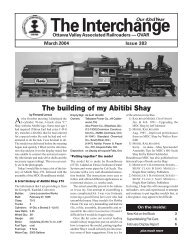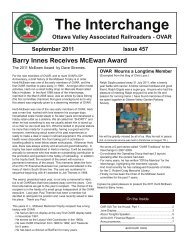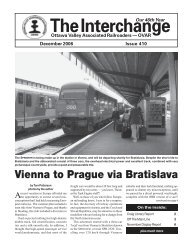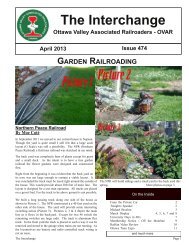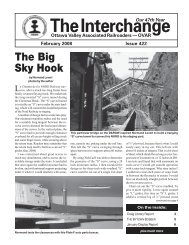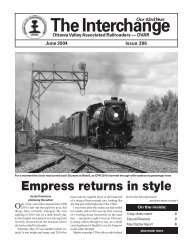March - Ottawa Valley Associated Railroaders
March - Ottawa Valley Associated Railroaders
March - Ottawa Valley Associated Railroaders
You also want an ePaper? Increase the reach of your titles
YUMPU automatically turns print PDFs into web optimized ePapers that Google loves.
The Interchange<br />
Our 43rd Year<br />
<strong>Ottawa</strong> <strong>Valley</strong> <strong>Associated</strong> <strong>Railroaders</strong> — OVAR<br />
by Normand Levert<br />
BAM — BAIKAL-AMUR MAGISTRAL<br />
(or Mainline) is a railway line in Russia.<br />
Traversing Eastern Siberia and the<br />
Russian Far East, the 4,234 km long BAM<br />
runs about 600 to 780 km north of, and parallel<br />
with, the Trans-Siberian railway. In<br />
2004 the longest tunnel on this line was finally<br />
completed, eliminating a tortuous bypass.<br />
The route of the present-day BAM was<br />
first considered in the 1880s as an option for<br />
the eastern section of the Trans-Siberian<br />
railway. BAM departs from the Trans-Siberian<br />
railway at Taishet (Tayshet), and then<br />
goes around Lake Baikal, which at 636 km<br />
long and 80 km wide, is the largest freshwater<br />
lake in Asia (31,494 km) and the deepest<br />
lake in the world (1,743 m). The BAM railway<br />
then goes to Amur, and connects with<br />
the east end of the Trans-Siberian Railway.<br />
BAM was built as a strategic alternative<br />
route to the Trans-Siberian Railway, especially<br />
to the vulnerable sections that are<br />
close to the border with China. Stalin ordered<br />
its construction. Work began with political<br />
prisoners in 1939. German and Japanese<br />
prisoners of war extended the railway in<br />
1944-46. Following Stalin’s death, virtually<br />
all construction work on the BAM stopped<br />
and the line was abandoned to the elements<br />
for more than twenty years.<br />
In <strong>March</strong> 1974 Soviet General Secretary<br />
Leonid Brezhnev stated that a new BAM<br />
project would become a huge Komsomol 1<br />
(Communist Union of Youth—see footnote<br />
below right) undertaking. In September<br />
1984 a “golden spike” was hammered into<br />
place, connecting the eastern and western<br />
sections of the BAM. No Western media<br />
were invited to attend this historic event, as<br />
Soviet officials did not want any questions<br />
asked about the line’s operational status and<br />
working conditions of the construction<br />
workers. In reality, only one third of the<br />
BAM’s track was fully operational at the<br />
time of opening, and the forced labour was<br />
...continued on page 3<br />
<strong>March</strong> 2005 Issue 393<br />
Baikal-Amur Magistral Railway<br />
Chertov Bridge on the BAM.<br />
The BAM traverses rich, unspoiled and stark areas. The line is partly electrified.<br />
1 —“Communist Union of Youth”. The organization<br />
served as the youth wing of the Communist Party<br />
of the Soviet Union), the youngest members being<br />
fourteen years old, the upper limit for an age<br />
of rank and file being 28, while komsomol functionaries<br />
could be older.<br />
On the inside:<br />
Craig Library Report 2<br />
Canso Rail Ferry 4<br />
February Display Report 6<br />
plus much more
“From the Carrel”<br />
The C. Robert Craig Memorial Library<br />
by Dave Knowles<br />
Iam delighted to announce that Bruce Curry<br />
has boarded the CRCML train as Photography<br />
Curator, and we will once again be<br />
able to service your requests for copies of<br />
images from our collection. Barry Innes and<br />
Tony Pearce are continuing to catalogue the<br />
collection. It is an interesting comment that<br />
apparently the NMRA library has over<br />
100,000 images but only about 20,000 catalogued.<br />
The CRCML has 31,386 catalogue<br />
entries and a much, much smaller backlog.<br />
As you may already know, the City<br />
Archives has received an extension of its<br />
lease at the current location in the former<br />
City Hall at 111 Sussex Drive and the Library<br />
will remain there at least until the end<br />
of 2005.<br />
In anticipation that we will get lots of lastminute<br />
inquiries about the 150th anniversary<br />
of railways in <strong>Ottawa</strong> I have placed a<br />
typescript reference copy of Bob Elliot’s<br />
IRON ROADS TO OTTAWA, on the shelves at<br />
the Library. This is a comprehensive study<br />
of the Bytown and Prescott Railway and its<br />
subsequent renamings. It is a considerably<br />
more extensive than Bob’s short booklet on<br />
the same subject. The book can be found at<br />
S.B&.P E1.1094<br />
New books that appeared recently have<br />
also been added to the Collection. J.F. Gardner<br />
has produced a third of his extremely<br />
well-illustrated books. All three are large<br />
hard cover books, 10"x11" landscape format,<br />
filled with excellent b&w and colour<br />
photographs. The first book is a collection of<br />
Nicholas Morant’s photography of the CPR<br />
[S.CPR G1. 81]. The second is BRITISH CO-<br />
LUMBIA RAILWAY: FROM PGE TO BC RAIL<br />
[not in the CRCML] and the new book is<br />
THE CROW AND THE KETTLE [S.CPR<br />
G1.1095]. This book covers CPR’s operations<br />
in southern B.C. and Alberta from<br />
1959-1989. The new book is particularly interesting<br />
for Fairbanks Morse fans as most<br />
of CPR’s fleet of these locomotives worked<br />
in the area. The photographs are well chosen<br />
and reproduction is excellent.<br />
Another is accurately but unimaginatively<br />
titled CANADIAN NATIONAL RAILWAY.<br />
Produced by Tom Murray [S. CNR<br />
M52.1092] it is a smaller book, 11"x8 1 ⁄2"<br />
and a short 159 pages. It concentrates on<br />
CNR, although predecessor railways are<br />
April 23-24: IROQUOIS – SEAWAY DIS-<br />
Current membership:<br />
TRICT MODEL RAILROAD SHOW &<br />
188<br />
SALE, Seaway District High School, Hwy.<br />
REMEMBER IF YOU CAN’T 401 to exit 738, south to Hwy. 2, east on<br />
MAKE THE DINNER PLEASE LET Hwy. 2 for 3 blocks. Sat. 10 a.m.-5 p.m.,<br />
PETER JOYCE KNOW Sun. 11 a.m.-4 p.m. Info: Jason Edge (613)<br />
noted in passing. There are some b&w pho-<br />
657-1392, e-mail: cuttingedge@ripnet.com<br />
2 The Interchange<br />
tos but the bulk are in colour. The author is<br />
an American and one gets the impression<br />
that this is directed at the American market.<br />
He cites most of the standard sources but<br />
you get the feeling he has done little if any<br />
original research. A good account for a newcomer<br />
to the field, but a little disappointing<br />
for the railfan.<br />
BRMNA has just published two more<br />
volumes Tim Horton’s BRITISH COLUMBIA<br />
RAILWAY, VOLUME THREE [S.BCR<br />
H12.1101] is the sixth and final volume of<br />
his series depicting this railway. The first<br />
three appeared under the title THE PACIFIC<br />
GREAT EASTERN RAILWAY, [S.PGE H12.]<br />
The second is LAWRENCE STUCKEY’S<br />
CANADIAN AND U.S. RAILWAY PHOTOG-<br />
RAPHY 1935-1957, [WP B1.110]. Longer<br />
than most BRMNA publications it contains<br />
a comprehensive account of Stuckey’s travels<br />
in search of railway subjects and a substantial<br />
number of the photographs that he<br />
took. All too few in the full page format.<br />
In addition a copy of Colin Hatcher’s<br />
STAMPEDE CITY STREETCARS (the Calgary<br />
Municipal Railways), which has long<br />
been on our list turned up at the OVAR flea<br />
market and has been added to our collection.<br />
[TG.CAL H1.1099]<br />
Although we have not yet received a copy<br />
of Ted Rafuse’s new book WOODEN CARS<br />
ON STEEL RAILS, we hope to receive a copy<br />
shortly. It is a very interesting account of the<br />
Crossen Car companies and their products.<br />
They were major supplier of cars to the<br />
CPR, before that company began to build its<br />
own, and many Canadian Northern cars also<br />
originated in its shops.<br />
Check out OVAR’s Web Site<br />
www.ovar.ca<br />
For the Record<br />
February Meeting:<br />
130<br />
LeBlanc<br />
reaches<br />
milestone<br />
John LeBlanc has been honored for 50<br />
years of continuous membership in the<br />
National Model Railroad Association.<br />
A certificate marking John’s achievement<br />
was presented to him by SLB Superintendent<br />
Stanley Conley at the February OVAR<br />
meeting.<br />
It’s not hard to realize that John has been<br />
in our hobby for a long time by the interesting<br />
cars and locos from the early days that<br />
he brings out for the monthly displays.<br />
John is the second 50-year NMRA<br />
member in OVAR. A couple of years ago<br />
Al Craig was honored for reaching the same<br />
milepost.<br />
TIMETABLE<br />
Upcoming events of particular<br />
interest to OVAR members<br />
<strong>March</strong> 19-20: TORONTO – TORONTO<br />
MODEL RAILWAY SHOW, Brookview Middle<br />
School, 4505 Jane St. Sat. 11 a.m.-6 p.m.,<br />
Sun. 10 a.m.-4 p.m. Info: (416) 536-2894 or<br />
email: modelshow@torontoyork.ca<br />
<strong>March</strong> 19-20: KINGSTON – RAIL-O-RA-<br />
MA, Portsmouth Olympic Harbour, 53 Yonge<br />
St. Sat. 11 a.m.-5 p.m., Sun. 10 a.m.-4 p.m.<br />
April 1: OTTAWA – Bytown Railway Society,<br />
Canada Science and Technology Museum,<br />
1867 St. Laurent Blvd. 7:30 p.m. Info:<br />
www.bytownrailwaysociety.ca<br />
April 6: CORNWALL – Moccasin Model<br />
Railroad Club, Nativity Hall, 7:30 p.m.<br />
Info: Chris Patrick, e-mail: cpatrick1@cogeco.ca<br />
April 15-17: BELLEVILLE – GRAND<br />
JUNCTION, NMRA NFR convention.<br />
www.nfr-nmra.org/
Smiths Falls<br />
Railway<br />
Museum victim<br />
of thieves<br />
Iam trying to reach the widest possible audience<br />
in the hopes of recovering a very<br />
important appliance from one of Canada’s<br />
few surviving operable Alco/MLW S-series<br />
units.<br />
Thieves have been busy again, this time at<br />
the Smiths Falls Railway Museum. Sometime<br />
between Sunday, February 6th and<br />
Wednesday, February 9th, the Leslie “snowplow<br />
whistle” 3-chime air horn was stolen<br />
from Canadian Pacific S-3 number 6591.<br />
This horn is in somewhat faded CPR maroon,<br />
although if it appears for sale it could<br />
be most any colour of fresh paint.<br />
If anybody hears word or rumours that<br />
somebody has a horn matching this description<br />
please contact the Museum at (613)<br />
283-5696 email:<br />
sfrmchin@superaje.com.<br />
You may also contact me directly at:<br />
s.c.hunter@sympatico.ca<br />
or<br />
Stephen.Hunter@nrc-cnrc.gc.ca.<br />
As well, if anybody can lead us to a replacement,<br />
please contact me!<br />
Thanks, everyone,<br />
Steve Hunter,Trustee, SFRM<br />
Peter McGuire mans his table at the OVAR Swap Meet.<br />
Laing shows derailed by city<br />
Hugh Laing has cancelled his popular<br />
toy and train shows at the Sportsplex<br />
because of huge rent increases imposed by<br />
the City of <strong>Ottawa</strong>.<br />
Hugh told the February OVAR meeting<br />
that the city had pushed through a 22 1 ⁄2% increase<br />
in rental fees for the Sportsplex and<br />
other city venues which would have brought<br />
the rental fee for the spring and fall shows to<br />
more than $3,000 a weekend. “These fees<br />
are not feasible for us.”<br />
He plans to continue with his summer<br />
show at the Smiths Falls Railway Museum<br />
in August.<br />
BAM<br />
continued from page 1<br />
still widely used. BAM was finally declared<br />
complete in 1991.<br />
However, akin to Canadian Pacific’s<br />
crossing of the Rogers’ Pass, BAM was<br />
opened with a circuitous and steep by-pass<br />
of a planned tunnel. Finally, the longest tunnel<br />
on the Baikal-Amur Mainline (BAM)<br />
was completed in 2004. A good link to find<br />
out more about this fascinating railway is:<br />
bam.railways.ru/eng/<br />
Today there is debate whether the BAM is<br />
folly or future. The planned developments<br />
along the BAM rail line have yet to materialize,<br />
so the mineral and industrial traffic<br />
potential remains unrealized. There would<br />
be six trains a day on this line. Yet BAM is<br />
shorter than the Trans-Siberian and may yet Chertov bridge on the BAM. Piers are concrete circular columns resting on massive<br />
prove to be a wise investment.<br />
footings. Middle pier footings sit on lower piers made of more circular columns.<br />
<strong>March</strong> 2005 3
The Canso<br />
and the C<br />
by Glenn Nixon<br />
photos from author’s collection<br />
Prior to 1955 and the construction of the<br />
causeway, Cape Breton Island was truly<br />
an island. There were various ferry services<br />
from as early as 1819, and rail ferries began<br />
in the 1890’s as part of the Intercolonial<br />
Railway. Initially rail cars were hauled on a<br />
barge behind the ferry until 1901 when the<br />
new S.S. SCOTIA Iwas able to carry rail cars<br />
itself. Heavier loads and increased traffic required<br />
the larger S.S. SCOTIA II which went<br />
into service in 1915 and it continued to provide<br />
service for the CNR until the causeway<br />
was completed in 1955.<br />
The photos in this article are all from our<br />
Leaving Port Hawkesbury.<br />
family collection, which I believe my father<br />
took while on the rail ferry crossing in October<br />
1946. From what I have been able to determine<br />
they are of the departure from Port<br />
Hawkesbury and arrival at Mulgrave on the<br />
mainland. Loading and unloading was accomplished<br />
by steam engine with idler flatcars,<br />
which avoided adding the weight of the<br />
engine onto the dock ramp or ferry.<br />
The Mulgrave station is visible in the<br />
background of one of the photos. If anybody<br />
can provide further detail or clarification<br />
about the photos I would be pleased to hear<br />
from them. Most of the background information<br />
for this article is the result of an internet<br />
search.<br />
Prior to the causeway, ferry service was<br />
quite a problem in winter due to heavy driftice<br />
moved by tides and wind. At times service<br />
was delayed or cancelled for days. The<br />
ferry would often steer a diagonal course<br />
through the ice to avoid being jammed while<br />
on route. There are records from April 5,<br />
1919 of wind driven ice was so severe that<br />
beside the dock in Mulgrave it packed solid<br />
to the bottom in a water depth of 29 feet. Before<br />
1940 the car ferries were laid up from<br />
January to April due to the ice. During such<br />
time, a few cars came over on the rail ferry.<br />
Later, the winter car ferry went to Point Tupper<br />
instead of Port Hawkesbury.<br />
The increasing need for year around reliable<br />
access led to the decision to build the<br />
causeway to provide a road, rail and power<br />
CNR passenger<br />
line link. The causeway was an engineering<br />
cars on ferry.<br />
and construction feat and it is the deepest<br />
4 The Interchange
Rail Ferry<br />
auseway<br />
causeway in the world—across water up to<br />
217 feet deep. Work began in 1952 to place<br />
the required 10 million tons of blasted granite<br />
rock from an adjacent quarry. The causeway<br />
was built in an S-shape with a rail and<br />
road curve at each end. It is nominally 4,300<br />
feet long and 80 feet wide at the crest to accommodate<br />
a 24-foot wide road, one rail<br />
track and a sidewalk. The top is 14 feet<br />
above high water level and there is maximum<br />
tide of 6 feet in the area. The base is<br />
860 feet wide at the deepest part of the<br />
ocean bottom.<br />
On the Cape Breton side there is a centre<br />
pivot swing bridge 308 feet long over a ship<br />
canal 80 feet wide by 30 feet deep. For safety<br />
of shipping using the canal there is a navigation<br />
lock to limit water movement due to<br />
tides and currents.<br />
Much has been written about the effects<br />
of the causeway on the region—both positive<br />
and negative. The causeway created<br />
what is essentially a deepwater fiord on the<br />
east side and thereby created an excellent<br />
year around, ice-free deepwater harbour at<br />
Port Hawkesbury. Mulgrave was the thriving<br />
community in the ferry days, but it has<br />
dwindled since opening of the causeway<br />
and at the same time Port Hawkesbury has<br />
grown due to all the economic development<br />
directly attributed to the port and the causeway.<br />
The official opening of the causeway was<br />
on August 13, 1955 and this year marks the<br />
50th anniversary. There are special commemoration<br />
events planned at the causeway<br />
the week of August 7 to 14. Check the websites<br />
listed below for details and have a look<br />
at the web cam.<br />
CNR rail ferry arrival at dock in Mulgrave, Oct ober 1946.<br />
Website references about the<br />
ferry and causeway:<br />
Canadian government historical information:<br />
collections.ic.gc.ca/scotiaferry<br />
Nova Scotia Railway Heritage Society:<br />
www.novascotiarailwayheritage.com<br />
Causeway 50th Anniversary Events:<br />
www.cansocauseway.ca<br />
Causeway WEB CAM:<br />
gov.ns.ca/tran/cameras/<br />
camdetails.asp?id=cansocauseway<br />
Off-loading<br />
rail ferry at<br />
Mulgrave,<br />
October 1946.<br />
<strong>March</strong> 2005 5
Dave Strong brought out two CPR passenger trains and brass CPR Hay Rack car, for which he received the CHAIRMAN’S CHOICE.<br />
Canadian equipment featured in February<br />
Ian Cranstone photos<br />
Dave Strong won the CHAIRMAN’S<br />
CHOICE award for the February display<br />
with his collection of HO CPR trains. They<br />
included CPR Hudson 2819 and three passenger<br />
cars as well as Northern 3100 and a<br />
string of Kettle <strong>Valley</strong> coaches. He also had<br />
a brass model of a CPR Hay Rack on display<br />
but it didn’t seem to have an agricultural<br />
function. A grand show.<br />
Dave Moat seems to be another CPR fan.<br />
Dave Moat lettered Accurail stock car for CPR using C-D-S dry transfers.<br />
He brought out four HO freight cars — a<br />
stock car made from an Accurail kit that was<br />
lettered with C-D-S, a boxcar from Branchline<br />
and two auto boxcars from Accurail<br />
models that were lettered with C-D-S. Good<br />
way to get brownie points with the display<br />
review guy, Dave. The cars were all weathered<br />
with Bragdon chalks and looked great.<br />
Bill Crago works the other side of the<br />
tracks. He had an HO CNR train powered by<br />
a J4e Pacific 5137 built by Samhongsa. It<br />
was pulling a CNR 1929 boxcar built from a<br />
Kaslo kit, a two-bay covered hopper from an<br />
upgraded Eastern Car Works kit and a Van<br />
Bill Crago’s CNR wayfreight’s markers were handled by Van Hobbies van.<br />
Hobbies van.<br />
We don’t get many structures in displays<br />
which is too bad when we see stations such<br />
as the one that Carl Swail scratchbuilt in<br />
HO. It is based on the station in St. Johnsbury,<br />
Vermont and the result of a lot of hard<br />
work is truly outstanding.<br />
Charlie Shrubsole displayed some of his<br />
S scale freight car projects. He had a CN<br />
single-sheathed box car that he built 20<br />
years ago, a TH&B boxcar that he built from<br />
a resin flat kit with some considerable frustration,<br />
a TH&B hopper which started as an<br />
Charlie Shrubsole says considerable frustration was involved with resin TH&B boxcar.<br />
6 The Interchange
American Models kit, an old Permabuilt car<br />
heavily upgraded to a CN 40-foot boxcar<br />
and lettered with C-D-S and a Pacific Rail<br />
Shops 40-foot CN boxcar. Each model undergoes<br />
a lot of work trying to get the details<br />
right, brake gear added etc.<br />
Bill Meredith showed off a brand new<br />
Cimarron Works Sn3 resin kit of a RGS box<br />
car. Cimarron offers delrin trucks, decals<br />
and Grandt Line brake gear with the kit. Bill<br />
also displayed Sn3 and On3 models of the<br />
D&RG duckbill coach that Cimarron Works<br />
is releasing next month. It will include decals,<br />
trucks and interior details.<br />
Bruce Morgan had a long string of old<br />
Canadian freight cars in HO. They were all<br />
well done, and included PGE reefer and<br />
gondola, CNoR reefer, AC gondola, CN<br />
stock car, TH&B boxcar, and GTP hopper.<br />
It seems that Normand (l’Agneau) Levert<br />
isn’t the only depressed centre flat car<br />
fan in OVAR. Jens Stehr brought out a 12<br />
axle HO model that he bought in Montreal.<br />
It was made of urethane as was the transformer<br />
it was carrying.<br />
Meanwhile Normand showed off his first<br />
attempt at scratchbuilding. It is a mill gon<br />
that Normand says has no weight.<br />
David Jeanes displayed a duckunder<br />
HOTrak module he has made of the nine<br />
tracks of the old <strong>Ottawa</strong> Union Station yard.<br />
He had mockups of the various structures<br />
that will in time grace the module.<br />
John Chambers brought out three Accurail<br />
HO 40-foot outside braced boxcar models<br />
in CN lettering. He had arch bar trucks<br />
and KC brake gear on them. They were all<br />
from the 500500 to 501249 class.<br />
John LeBlanc had a CN work train that<br />
included diesel crane 586, boom car 57300,<br />
tool car 56172 and bunk car 53408. All were<br />
early Silver Streak wood kits except for the<br />
crane.<br />
Bud Nelson also had a work train but this<br />
one was an HO ONR version. It included a<br />
Kato engine, a crane suspected of having<br />
IHC origins, an Athearn boom car and a<br />
Gord Bellamy showed Canada Western flat in true “piggyback” service.<br />
Carl Swail scratchbuilt model of St. Johnsbury, Vermont station.<br />
Roundhouse van. They were all painted by<br />
Bud’s son Craig.<br />
Gord Bellamy had an Athearn piggyback<br />
flat that was lettered for his Canada Western.<br />
Jean-François Milotte displayed one of<br />
the new Broadway SW7’s with all the<br />
sounds, bells and whistles. It was painted for<br />
the ON&W by Bill Sn3.<br />
Charls Gendron displayed three new<br />
Overland Models HO diesels. They were a<br />
SOO SD60M, a Chemin de fer Matapedia et<br />
Gulf and an Algoma Central FP9A that<br />
Charls had modified and custom painted.<br />
Peter Cunningham brought out a Proto<br />
1000 Boston and Maine RS2 that was<br />
straight out of the box. He said units like this<br />
were seen in <strong>Ottawa</strong> in the mid 1960s.<br />
David Knowles displayed an AT&SF gas<br />
electric railcar that was made in 1975 by<br />
Rok-Am of Korea and sold for $100. The<br />
prototype for this car is at the California<br />
State Railway Museum in Sacramento.<br />
Paul Norton brought out a G scale NW2<br />
painted and lettered for CNR. It had undergone<br />
the customary “Nortonization” to run<br />
from battery packs and an Aristo Craft controller.<br />
Fred Mills noted that Paul is one of<br />
the North American authorities on batterypowered<br />
radio controlled locomotives. For<br />
more, see the <strong>Ottawa</strong> garden railway web site:<br />
www.ovgrs.org<br />
Brian Earl brought out an interesting bit<br />
of railway history — a brick stamped JRB<br />
from an archeological dig his son did on the<br />
Lebreton flats. The bricks was used in building<br />
Booth company houses. The homes<br />
were destroyed in the great 1910 fire.<br />
Booth brick was shown by Brian Earl.<br />
John LeBlanc brought out work train built around CNR crane 586 and boom tender 57300.<br />
<strong>March</strong> 2005 7
2004-2005<br />
OVAR<br />
Directory<br />
Next Meeting<br />
A railfan’s look back,<br />
a look around,<br />
and a look at the future<br />
presented by<br />
Ken Goslett<br />
Canadian railways and North American railroads...<br />
what we’ve lost and what we’ve gained.<br />
A presentation of original slides, anecdotes and opinion.<br />
Display<br />
Jigs, structures, train memorabilia, photos, calendars, books<br />
and research material — bring out what you consider priceless,<br />
it is “show and tell” time.<br />
Tuesday, April 12<br />
St. Anthony Soccer Club Hall<br />
523 St. Anthony Street, <strong>Ottawa</strong><br />
(just off Preston Street at the Queensway)<br />
Doors open at 5:30 p.m.<br />
Dinner served at 6:30 p.m.<br />
Admission: $20.00<br />
Includes dinner, facilities, program expense, taxes and gratuities.<br />
Free parking.<br />
Please note:<br />
If you cannot attend the meeting after saying you would, please call<br />
Peter Joyce at 841-1950. Thank you.<br />
Chairman: Bud Nelson 819-837-3350<br />
Vice-Chairman: Fern Leroux 613-830-9979<br />
Secretary: Mike Shore 613-829-8867<br />
Treasurer: Gord Bellamy 613-725-6979<br />
Membership: Bill Meek 613-521-3234<br />
Program: Norm Levert 613-834-6798<br />
Dinner: Peter Joyce 613-841-1950<br />
Archives: Dave Knowles 613-722-4473<br />
Webmaster: Steve Watson 613-592-3609<br />
Web Site:<br />
www.ovar.ca<br />
THE INTERCHANGE<br />
<strong>March</strong> 2005 — Issue 393<br />
Editorial Staff<br />
Features, Story Ideas,<br />
Comments and Complaints<br />
Alex Binkley<br />
152 Ivy Cres., <strong>Ottawa</strong>, ON K1M 1X6<br />
Phone: 613-749-7633<br />
e-mail: alex.binkley@sympatico.ca<br />
Prototype Railroading, Photographs,<br />
Regular Departments:<br />
Ian Cranstone<br />
3715 Campbellcroft Rd.<br />
Box 634, Osgoode, ON K0A 2W0<br />
Phone: 613-821-7423<br />
e-mail: lamontc@nakina.net<br />
Distribution and Mailing:<br />
Mike Shore<br />
25 Bainbridge Ave., <strong>Ottawa</strong>, ON K2G 3T1<br />
Phone: 613-829-8867<br />
e-mail: mshore1@rogers.com<br />
Submission of Articles:<br />
THE INTERCHANGE welcomes your submissions<br />
that may be of interest to club members. Please<br />
send them to one of the departments listed above.<br />
Material submitted can be handwritten, typewritten,<br />
on floppy diskette, or sent via e-mail.<br />
Copy Deadline:<br />
April <strong>March</strong> 20<br />
Printing and Copying:<br />
Impression Printing, Smiths Falls<br />
THE INTERCHANGE is published eleven times a year,<br />
September through June and Summer, by the <strong>Ottawa</strong><br />
<strong>Valley</strong> <strong>Associated</strong> <strong>Railroaders</strong>. Opinions expressed<br />
in THE INTERCHANGE are those of the Editors<br />
or individual authors, and are not necessarily<br />
those of OVAR. © 2005



